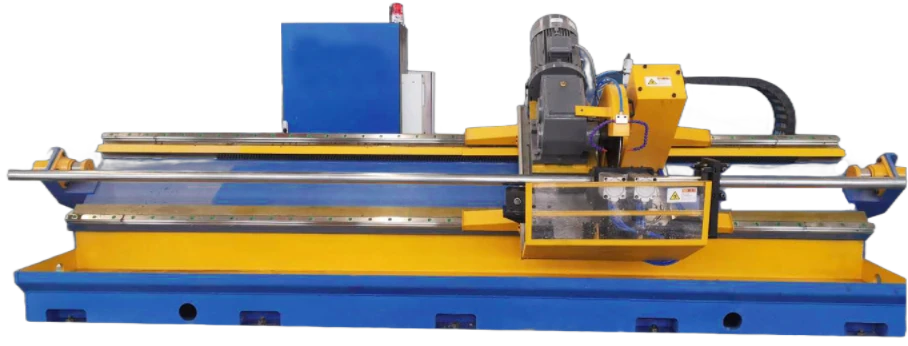straightening press machine
Understanding the Straightening Press Machine A Key Player in Metal Fabrication
In the dynamic world of metal fabrication, precision and efficiency are paramount. Among the various machines utilized in this industry, the straightening press machine stands out as an essential tool. This piece of equipment is designed to correct and straighten metal pieces that may have been warped or bent during processing. By understanding the workings, benefits, and applications of straightening press machines, we gain insights into their vital role in metal manufacturing.
What is a Straightening Press Machine?
A straightening press machine is specifically engineered to restore the straightness of metal materials, such as sheets, plates, and bars. The machine operates through a hydraulic or mechanical system that applies controlled pressure to the metal workpiece. This pressure helps eliminate distortions, ensuring that the final product meets stringent dimensional and quality standards.
The design of straightening press machines can vary, but they commonly include a large frame, hydraulic cylinders, and a bed or anvil upon which the metal is placed. Advanced models often feature digital controls, enabling operators to set precise parameters for pressure and positioning, leading to improved consistency and repeatability in production processes.
How Does It Work?
The operation of a straightening press involves several steps. First, the operator positions the warped or bent metal piece on the machine's bed. The hydraulic system is then activated, applying a predetermined amount of force to the metal. This force is carefully calculated based on factors such as the type of material, its thickness, and the degree of distortion.
As pressure is applied, the metal begins to deform in response to the force, effectively reversing the bending or warping. The process may take a few seconds to several minutes, depending on the specific requirements of the workpiece. Once the metal has been straightened to the desired specification, the pressure is released, and the operator can remove the now-rectified piece for further processing.
Benefits of Using a Straightening Press Machine
straightening press machine

1. Enhanced Precision A straightening press machine offers a high degree of accuracy, which is critical in industries where tight tolerances are necessary. This precision minimizes the risk of defects and improves product quality.
2. Increased Efficiency By automating the straightening process, manufacturers can significantly reduce the time and labor involved in correction tasks. This efficiency translates to higher output rates and lower operational costs.
3. Versatility These machines are capable of accommodating various types of metals and shapes, making them versatile tools in a fabrication shop. Whether straightening steel, aluminum, or other materials, the straightening press is adaptable to meet different needs.
4. Reduced Material Waste By effectively straightening metal components, the need for reworking or scrapping defective parts is minimized, contributing to sustainable practices in manufacturing.
Applications in the Industry
Straightening press machines are utilized across multiple sectors, including automotive, aerospace, construction, and manufacturing. In the automotive industry, they play a crucial role in straightening chassis components and body panels, ensuring safety and performance. In aerospace, they help produce aircraft parts that require stringent adherence to specifications.
Moreover, metal service centers frequently employ straightening presses to prepare raw materials for resale or further processing. Their ability to restore the integrity of metal sheets and plates makes them indispensable in maintaining a steady supply of quality materials to fabricators.
Conclusion
The straightening press machine is a cornerstone of modern metal fabrication, providing a blend of efficiency, precision, and versatility. As industries continue to evolve and demand higher standards of quality and performance, these machines are poised to play an increasingly vital role. By investing in advanced straightening technology, manufacturers can ensure they remain competitive in a challenging market landscape, producing straightened metal components that meet the highest benchmarks. Understanding and leveraging the capabilities of straightening press machines will undoubtedly contribute to the advancement of metal fabrication processes, paving the way for innovation in various applications.
-
High Frequency Straight Seam Welded Pipe Production Line-BzZhou Xinghua Machinery Equipment Manufacturing Co., LTD.|line pipe steel&welded gas pipeNewsJul.30,2025
-
High Frequency Straight Seam Welded Pipe Production Line-BzZhou Xinghua Machinery Equipment Manufacturing Co., LTD.|High Precision&Automated SolutionsNewsJul.30,2025
-
High Frequency Straight Seam Welded Pipe Production Line - BzZhou Xinghua Machinery Equipment Manufacturing Co., Ltd.NewsJul.30,2025
-
High Frequency Straight Seam Welded Pipe Production Line-BzZhou Xinghua Machinery Equipment Manufacturing Co., LTD.|Precision Welding, High EfficiencyNewsJul.30,2025
-
High Frequency Straight Seam Welded Pipe Production Line|BzZhou Xinghua|Precision Welding&EfficiencyNewsJul.30,2025
-
High Frequency Straight Seam Welded Pipe Production Line - BzZhou Xinghua|Precision Engineering&EfficiencyNewsJul.30,2025


